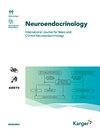Transcriptomic Profiling of Lactotroph Pituitary Neuroendocrine Tumors via RNA Sequencing and Ingenuity Pathway Analysis.
IF 3.2
2区 医学
Q2 ENDOCRINOLOGY & METABOLISM
引用次数: 0
Abstract
INTRODUCTION Lactotroph pituitary neuroendocrine tumors (PitNETs) are common pituitary tumors, but their underlying molecular mechanisms remain unclear. This study aimed to investigate the transcriptomic landscape of lactotroph PitNETs and identify potential molecular mechanisms and therapeutic targets through RNA sequencing and ingenuity pathway analysis (IPA). METHODS Lactotroph PitNET tissues from five surgical cases without dopamine agonist treatment underwent RNA sequencing. Normal pituitary tissues from three patients served as controls. Differentially expressed genes (DEGs) were identified, and the functional pathways and gene networks were explored by IPA. RESULTS Transcriptome analysis revealed that lactotroph PitNETs had gene expression patterns that were distinct from normal pituitary tissues. We identified 1,172 upregulated DEGs, including nine long intergenic noncoding RNAs (lincRNAs) belonging to the top 30 DEGs. IPA of the upregulated DEGs showed that the estrogen receptor signaling, oxidative phosphorylation signaling, and EIF signaling were activated. In gene network analysis, key upstream regulators, such as EGR1, PRKACA, PITX2, CREB1, and JUND, may play critical roles in lactotroph PitNETs. CONCLUSION This study provides a comprehensive transcriptomic profile of lactotroph PitNETs and highlights the potential involvement of lincRNAs and specific signaling pathways in tumor pathogenesis. The identified upstream regulators may be potential therapeutic targets for future investigations.通过 RNA 测序和 Ingenuity Pathway 分析对乳垂体神经内分泌肿瘤进行转录组学分析
简介嗜乳垂体神经内分泌肿瘤(PitNETs)是常见的垂体肿瘤,但其潜在的分子机制仍不清楚。本研究旨在通过RNA测序和巧妙通路分析(IPA)研究泌乳素垂体神经内分泌瘤的转录组图谱,并确定潜在的分子机制和治疗靶点。方法对5例未经多巴胺激动剂治疗的手术病例的泌乳素垂体神经内分泌瘤组织进行RNA测序。三名患者的正常垂体组织作为对照。结果转录组分析表明,泌乳素瘤具有不同于正常垂体组织的基因表达模式。我们发现了 1,172 个上调的 DEGs,其中 9 个长基因间非编码 RNA(lincRNA)属于前 30 个 DEGs。上调DEGs的IPA显示,雌激素受体信号转导、氧化磷酸化信号转导和EIF信号转导被激活。在基因网络分析中,EGR1、PRKACA、PITX2、CREB1和JUND等关键上游调控因子可能在泌乳素瘤PitNET中发挥关键作用。已确定的上游调节因子可能是未来研究的潜在治疗靶点。
本文章由计算机程序翻译,如有差异,请以英文原文为准。
求助全文
约1分钟内获得全文
求助全文
来源期刊

Neuroendocrinology
医学-内分泌学与代谢
CiteScore
8.30
自引率
2.40%
发文量
50
审稿时长
6-12 weeks
期刊介绍:
''Neuroendocrinology'' publishes papers reporting original research in basic and clinical neuroendocrinology. The journal explores the complex interactions between neuronal networks and endocrine glands (in some instances also immunecells) in both central and peripheral nervous systems. Original contributions cover all aspects of the field, from molecular and cellular neuroendocrinology, physiology, pharmacology, and the neuroanatomy of neuroendocrine systems to neuroendocrine correlates of behaviour, clinical neuroendocrinology and neuroendocrine cancers. Readers also benefit from reviews by noted experts, which highlight especially active areas of current research, and special focus editions of topical interest.
 求助内容:
求助内容: 应助结果提醒方式:
应助结果提醒方式:


